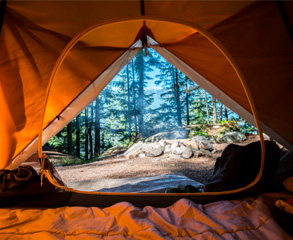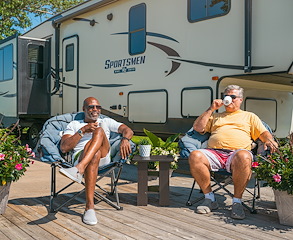How to Prevent Bug Bites While Camping
Bugs. These almost alien-like creatures can range from the good, the bad, and the OMG what is THAT!? While not all of them are as dangerous as they might look, you'll still want to prevent bug bites and stings while on vacation in the great outdoors.
Whether invited or not, these creepy crawlers are a typical part of any camping experience. So, we've provided some tips on how to deal with any bites or stings from these buggy intruders.
Common Campground Bugs
There are approximately 91,000 identified species of insects in the United States, and it can sometimes feel like they descended upon your campsite all at once. Here are the most common bugs you are likely to encounter while camping, along with some you really do not want to come across while exploring the great outdoors.
Battling Bug Bites
While obviously not a comprehensive list of offensive insects, here are the top bothersome bugs of outdoor enthusiasts everywhere. Try these easy suggestions on how to keep bugs away; if those don't work, there are tips on what to do when stung or bit.
No-See-Ums
Swarms of these tiny flying insects can quickly ruin an outdoor vacation. These nasty gnats are hard to spot but leave a painful reminder they were there. Itchier than mosquito bites, these bites can turn into welts and be bothersome for as long as two weeks.
Ways to Clear Away No-See-Ums
The easiest way to deter these pesky biters is to recognize what attracts them in the first place.
- Like mosquitos, these bugs like wet areas, and tall grasses, as well as piles of brush and debris.
- Keep lights dim or off, or use yellow compact fluorescent lights, to reduce their numbers.
- Squirt yourself and your campsite with an essential oil combination including mint, lemon, and eucalyptus.
- Reinforce window and door screens with a spray of DEET or permethrin.
- Wear long sleeve shirts, long pants, and insect repellent.
Remedies to Soothe No-See-Um Bites
Scratching can lead to infection so try one of these tips to stop the itch:
- Apply ice to numb the bites.
- Try toothpaste or rubbing alcohol.
- Aluminum chloride found in many antiperspirants is also effective in managing painful bites.
- Keep an over-the-counter remedy on hand.
Mosquitoes
Did you know there are 200 species of mosquitoes in the United States, and 3,000 worldwide? The female does the biting, blood-sucking, and transmitting of diseases including the West Nile virus. Eggs hatch in standing water found in areas like old tires, flowerpots, kid pools, puddles, and ponds.
How to Prevent Mosquito Bites
Take these precautions to prevent not only mosquitoes but many pesky pests.
- Do not let water collect. This is a perfect breeding ground for mosquitoes and other bugs.
- Wear light-colored clothing that covers arms and legs completely.
- Consider wearing a head/hat net when taking to the trails or sitting fireside.
- Use a small house fan outside to keep the air moving so mosquitoes can't land.
- Try a chemical repellent like DEET bug spray when out in the deep woods.
- Citronella, catnip, basil, and rosemary are pleasant-smelling forms of repellent. Rub to release the natural oils and apply to exposed skin. Place near entrances to keep bugs out of an RV or cottage.
Ouch! How to Stop Mosquito Bites from Itching
There are almost as many mosquito bite treatments as there are mosquitoes. Here are our favorite tips:
- Apply an ice pack to the area for 10 minutes.
- Rub basil or peppermint leaves on the bite.
- Apply a mixture of baking soda and water.
- Believe it or not, a banana peel works too.
- Dap a drop of vinegar on the spot.
- Try an over-the-counter product like calamine lotion.
Deer Fly
When you get bit by one of these, or the larger horse fly, you know it. Unlike mosquitoes or ticks that suck up blood, female deer flies have scissor-like jaws that slice through the skin. The fly's saliva is a blood thinner, making it easier to feed longer.
Deer Fly Deterrents
Deer flies are persistent when hungry and have been known to chase their prey. Keep deer fly away with these simple suggestions:
- Stay away from wearing blue or dark colors. Deer flies are attracted to the color blue which is why many bug catchers are that hue.
- Wearing stripes may confuse and discourage the flies from landing. Works for zebras.
- Use the bug repellent picaridin.
- Try a spray mixture of eucalyptus, citronella or other lemony essential oils and vinegar.
Oh Dear! What to Do When Bitten by a Deer Fly
- Treat the area with an antiseptic ointment.
- Cool the itch with an ice compress.
- Use natural homemade remedies like aloe vera or vinegar applications.
Ticks
They don't jump or fly, but instead climb long grasses and weeds where they wait for a warm-blooded creature to stroll past for them to hitch a ride (and a snack). In fact, they're so small, you might not even notice one on you until it becomes engorged and easier to see. Deer ticks are responsible for transmitting Lyme disease, among other illnesses.
How to Avoid Ticks While Camping
- Use permethrin. Douse your clothes, shoes, sleeping bag and tent area with this insecticide. Do NOT apply it directly to skin or wear the clothes while applying the spray. Wait for clothes and items to dry completely before using and spray in a well-ventilated area.
- Wear light-colored clothing and keep it tucked in. If ticks can't get to skin, they can't bite.
- Set up in a sunny area if you can. Ticks prefer wet, shady areas and can dry out in the sun.
- Keep to groomed trails to avoid tick habitats like tall grasses, flowers, and leaf piles.
- Get up. Sitting on a log or the ground is an open invitation to lunch for a tick. Use camping chairs and inspect them before relaxing.
- Check yourself for ticks at least twice a day. Look under cuffs and hems of clothing and pay special attention to the back of the knees, behind ears and neck, armpits, and ankles. You'll want to check these areas on pets as well.
How to Treat a Tick Bite
Unlike other biting insects, ticks will burrow into a host and not let go. Never removed a tick? Below is a simple explanation of how to remove a tick safely and effectively.
- Use clean tweezers and grab the tick as close to the skin as possible. Pull it out using a slow and steady upward motion. Don't twist, squeeze or yank.
- Wash the area and your hands well afterward.
- Save the tick. If you develop any health issues, having the tick may be beneficial in identification and treatment. Take a photo of the tick or attach the culprit to a piece of tape and put it in a baggie.
- Monitor yourself. Contact a health care provider if you experience flu-like symptoms accompanied by rashes, bumps, or spots around the bite area.
Bugs with Benefits
Don't swat these bugs with benefits. Looks can be deceiving on a couple of them, but some bugs are good to have around a campground as they help eliminate bad bugs and pollinate plants.
Dragonflies
Like tiny helicopters, dragonflies use their four wings to fly in any direction, including sideways and hovering. Dragonflies are efficient midair hunters, catching and eating hundreds of mosquitoes daily.
Bumblebees
These round and fuzzy stripped flyers are the G.O.A.T of pollinators. Their wings can beat 130 or more times per second, allowing them to buzz between flowers faster while dispersing more pollen.
Ladybugs
These mini-watermelons lookalikes feed on pests that damage gardens and crops. One ladybug can consume 5,000 insects during its two-year-long lifecycle.
Fireflies
Also known as lightning bugs, these flying beacons send signals back and forth to each other to find a mate. The chemicals released, luciferin and luciferase, are currently being used in research on cancer, multiple sclerosis, cystic fibrosis, and heart disease.
Praying Mantis
Don't let their pious positioning fool you. Praying Mantis are excellent hunters, using 3-D vision and camouflage to stalk mosquitoes and flies.
What IS that Bug!?
Some creepy crawly bugs are best left alone. A bite or sting by one of these can cause some serious health issues and should be looked at right away by a health professional.
Scorpions
Related to spiders, these venomous arachnids primarily live in desert-like conditions but have been found in mountain areas, grasslands, and forests. Mostly nocturnal, these creatures are hard to see but easy to recognize with their pincers and upturned tails. Stay away from the tail, where the venomous stinger is. Most scorpion stings will not kill a full-grown human, but they will hurt and can cause allergic reactions.
Spiders
The saying you are never more than three feet from a spider may be an exaggeration, but there are certain eight-legged creatures that you will want to stay far, far away from. Found across the U.S., the bites from some of the most poisonous spiders include the brown recluse, black widows and hobo spiders won't kill you but can make a person extremely sick.
Fire Ants
Not to be confused with ants in your pants, these tiny stinging stowaways from South America make a meal out of anything they come across. When one ant goes into attack mode, the others in the colony quickly follow. Distributing a nest is not recommended.
Tips for A Bite-Free Camping Experience
There are numerous ways to keep some of the more bothersome bugs from being a pain while camping. Here are some of our favorite ways the bugs away:
- Bring or plant flowers that discourage meddlesome bugs like marigolds, citronella, and fresh herbs. In addition to smelling great, the herbs can be used in cooking too.
- Wrap up fresh sage and rosemary in foil packets. Poke holes in the packet and place them in the campfire. The scent not only keeps bugs away, but it's also pleasant for people.
- Stay indoors during peak buggy time which is typically sunset and sunrise.
Don't let biting bugs or insects spoil a vacation. Share these tips and suggestions so others can enjoy an outdoor adventure free of bug bites.








